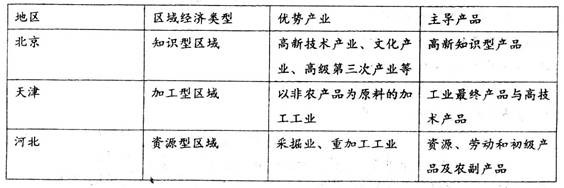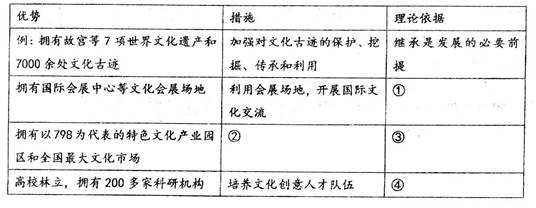京津冀产业版图正在悄然重构——北京,不再摊大饼,正腾笼换鸟,构筑“高精尖”产业体系,努力打造“文化中心”;天津,协同上下功夫,错位上做文章,发力做实“北方经济中心”:河北,纵使伤筋动骨也要脱胎换骨,打响压减过剩产能攻坚战,渴盼借力京津绿色崛起……。
阅读材料,回答问题。
材料一:目前京津冀地区经济特点比较

材料二:京津冀地缘相接、人缘相亲,文化一脉,渊源深厚,在产业结构、发展基础、资源禀赋等方面互补性很强,相互融合、协同发展空间巨大。推动京津冀协同发展,协同推进基础设施相连相通、产业发展互补互促、资源要素对接对流、公共服务共建共享、生态环境联防联控。三地党委和政府要着力加强顶层设计,抓紧编制首都经济圈一体化发展的相关规划。打破一亩三分地思维定式,真正实现“一加一大于二、一加二大于三”的效果。
北京打造“文化中心”。需要从多方面采取措施。根据示例,运用《文化生活》相关知识完成下表。

参考答案:
1.文化在交流中传播。
2.大力发展文化产业。
3.文化与经济相互影响、相互交融。
4.人民群众是文化创造的主体。
解析:本题知识限定不明确,题目类型措施类、原因类,问题指向北京打造文化中心的举措和依据。此类题目需要对所给材料信息进行解读,题中举措利用会展场地,开展国际文化交流,其依据是文化在交流中传播;题中北京优势在于特色文化产业园区和全国最大文化市场,针对这一优势的措施,就要大力发展文化产业,其理论依据就是文化与经济相互影响、相互交融;题中举措培养文化创意人才队伍,其依据是人民群众是文化创造的主体。
